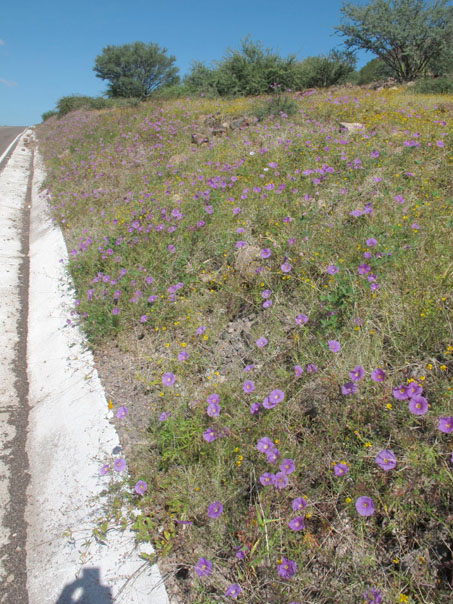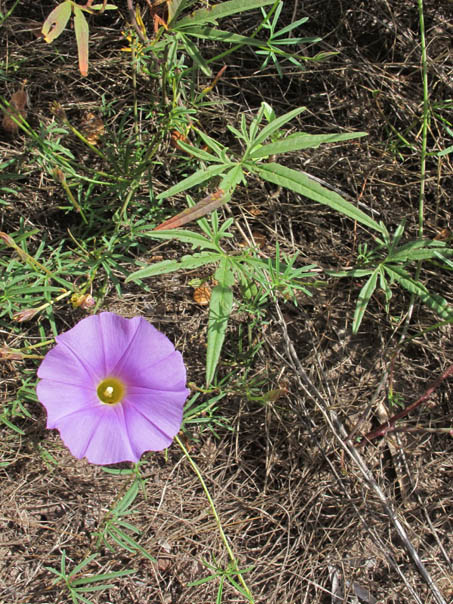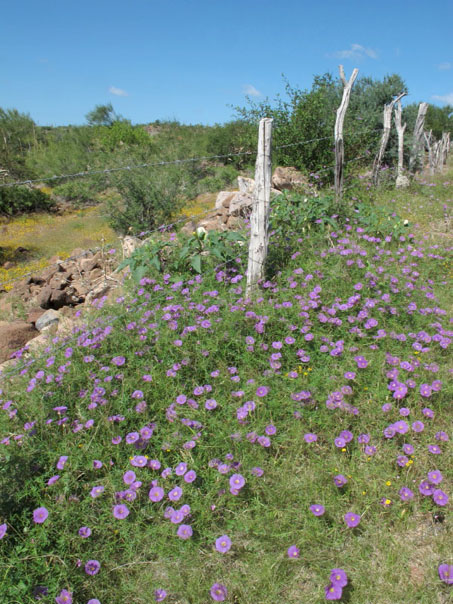BEE ENERO 2014
Northern BC — Aftermath of Tropical Storm Octave — Fall Flowers
¡Hola! I´m back in Baja California and ready to share my field adventures with you all. I´ve been looking forward to writing for the BEE, but due to travel, field work and other committments, I´ve missed the deadlines for the last two issues. But below, I´ve started from the beginning of our trip south in early October. I hope you'll enjoy following along!
Oct 11-22, 2013
We crossed into Mexico October 11th and took almost two weeks to reach Mulegé. Some parts of the peninsula seemed to be greener than in the past few years, due mostly to intermittent rains in the summer. Not lush, but not shriveled either. There were places along the way throughout the Central Desert where plants that commonly lack leaves by October, were still quite green. Pachycormus discolor, a species of Elephant tree (Anacardiaceae), is the dominant tree in some areas, alongside the shrubs known locally as Cirio and Ocotillo (Fouquieria columnaris and F. splendens, Fouquieriaceae). All were looking very leafy and healthy throughout much of the Central Desert.
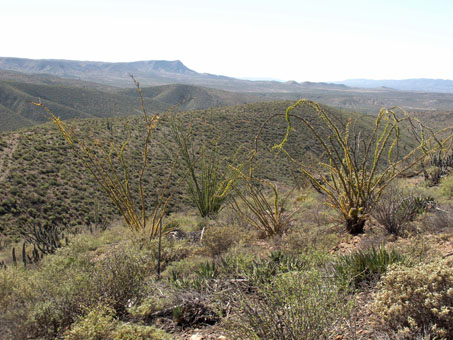 Ocotillo on Cuesta La Turquesa coastal scrub ecotone, just south of El Rosario (Fouquieria splendens).
Ocotillo on Cuesta La Turquesa coastal scrub ecotone, just south of El Rosario (Fouquieria splendens).
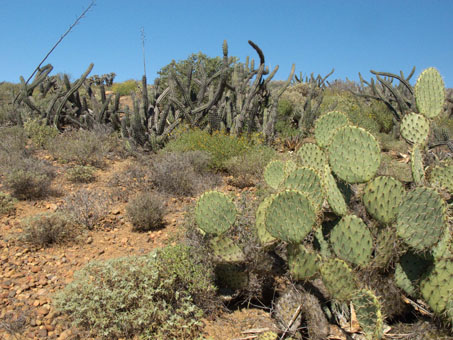
Prickly pear (Nopal, Opuntia sp.) and Pitahaya agria (Stenocereus gummosus) in coastal scrub ecotone.
The week we spent on the Pacific side in Guerrero Negro was unseasonably warm and dry in the daytime and quite muggy at night. I had hoped that there might be some annuals in the dunes, but we seem to have missed out on them this time. The desert was quite productive though when it came to cactus fruit. Every so often, a car would be parked along the road and a couple of people or a family with kids could be seen wandering out in the desert with a 5 gallon bucket in hand and a long stick. They were collecting the baseball sized Pitahaya agria fruit (Stenocereus gummosus), which they turn into a very yummy agua fresca after putting it in the blender with ice cubes, a little sugar, and some water. The fruit’s texture is reminiscent of watermelon but has very tiny black seeds. Once turned into a smoothie, it has a slightly gelatinous nature.
Most of the fruit was being collected near Vizcaíno, south of Guerrero Negro, where there is an area of very dense desert scrub that was incredibly lush. Though we were still more than 100 miles away, the conditions there and around Vizcaino were a promising sign for what might be expected on the Gulf side as well.
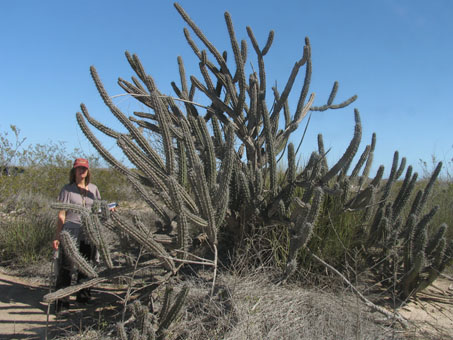
Pitahaya agria or Galloping Cactus
(Stenocereus gummosus, Cactaceae).
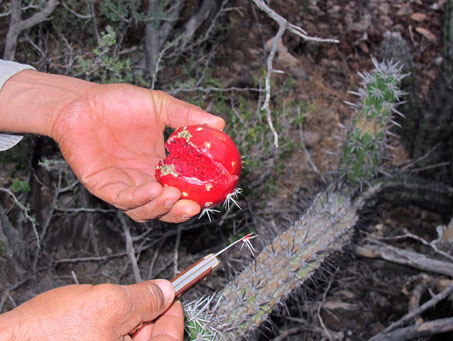
Pitahaya agria fruit.
Most of the summer, I had followed what was happening in Baja California and specifically Mulegé through my friends' Facebook posts. Beginning in late July and August, there were reports of intermittent rain both on the coast and in the mountains.
In all, it turned out to be a wet year, with 16 named tropical storms in the Eastern Pacific between May 15 and November 4. Three of them, tropical storms Ivo, Juliette, and Kiko, occurred during an 11 day period between August 22 and September 2, with flooding around the Cape and La Paz, and major highway washouts reaching north beyond Loreto.
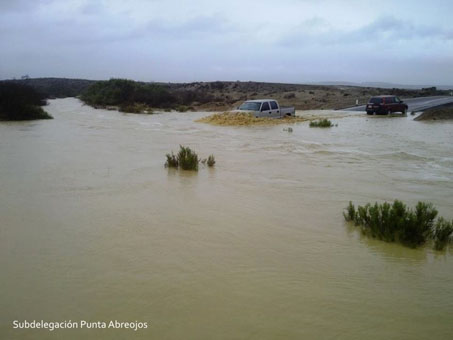
Flooding across highway in vado (wash), Punta Abreojos, on Pacific Coast. Water flows fast and deep. Tropical storm Ivo, August 24.

Flashflood in arroyo bed, Santa Rosalía. The town is built in the bottom of a deep arroyo. This is minor.
Tropical storm Juliette, August 28. (Photo credit: unknown)
In September, the peninsula got a little bit of a reprieve before tropical storm Octave showed up on October 13 and stalled off the coast, dumping lots of water. This storm was probably the most damaging due to heavy rains and flash floods. In a 48 hour period, San José del Cabo registered 130 mm (5.12 inches), Loreto 205.2 mm (8.08 inches) and Mulegé 91 mm (3.58 inches).
Now, the average annual rainfall for the Mulegè area is only 30 to 70 mm (1.18 and 2.75 inches) (Rebman and Roberts 2012, Baja California Plant Field Guide).
Fortunately, Octave did not result in flooding in Mulegé, and it turned out to be the last storm to affect the town this hurricane season, though storms kept forming in the Pacific until early November and we experienced both cold and warm fronts from the instability.
While Mulegé made it through the summer unscathed, it seemed like my friends in town spent a lot of it on heightened alert. But with the experience of six major floods, three of them devastating to the town’s infrastructure and economy, they say they will no longer take these summer storms for granted and would rather be seen as being too cautious than not cautious enough.

Bridge washout south of Mulegé. Fortunately, the paved detours were as good as, or better than, the original highway. This project is a massive repair job to this fairly new bridge.

While the bridge itself held up across this huge arroyo, the roadbed connecting to the bridge washed out, leaving the pavement above appearing mostly intact, but unsupported.
October 22-28, 2013
Mulegé, at last! When we first reached the Gulf of California, and dropped down into Santa Rosalía (the first Gulf town in BCS that the highway passes through) it didn´t look very promising for botanizing. The hills showed just a little new growth for the next 15 to 20 miles. But at about 10 to 15 miles north of Mulegé, the landscape rapidly became greener. It was a perfect example of the serendipitous nature of rainfall in the desert. The town was vibrant with growth.
With all of the greenery, I was anxious to get into the field as soon as we arrived. Fortunately it was not very hot, but it was somewhat humid, and there were a lot of mosquitoes, so it was important to get out as early as possible before the bugs and humidity got us. We were up and out at O-crack-30 on only our second day in town, looking mainly for summer annuals that might still be present. Unfortunately we had some car trouble and the field trip was cut short, but not before getting lots of great photos and adding a species of Boerhavia to the checklist.
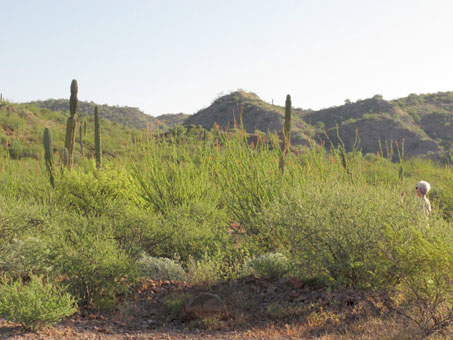
Green hills north of Mulegé. The shrubs were heavily leafed out and there was a lot of ground cover as well this season.
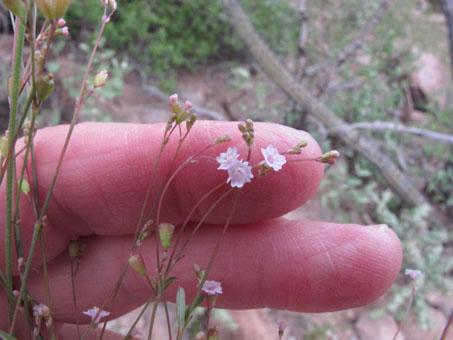
Spiderling. (Boerhavia triquetra var. triquetra, Nyctaginaceae)
While stranded at home the following day without a reliably funcioning car, our friend John Rebman, Botany Curator at the San Diego Natural History Museum and his field assistant John LeGrange pulled in for the night. They were on their way south to meet up with other team members of the Binational Multidisciplinary Expedition to the Sierra Cacachila (just south of La Paz) that was starting later in the week. (To see a short video trailer of the expedition, click here; or read an article from Jan. 27th describing the expedition).
They were going to continue their trip south in the morning, but had time to do some fieldwork with us. Jon asked me if there was a particular hillside that I was unable to climb that they could botanize for me, so the next morning we set out for the Ojo de Agua and the steep rocky outcrop that rises up behind it. While the guys climbed up the hill, my partner and I hung out around the bottom looking for bryophytes and other plants of interest. We saw numerous places with biological soil crusts and the beginnings of mosses poking out. There were also lots of fleshy fungi in the very damp soil, not a very common sight in this normally arid environment.
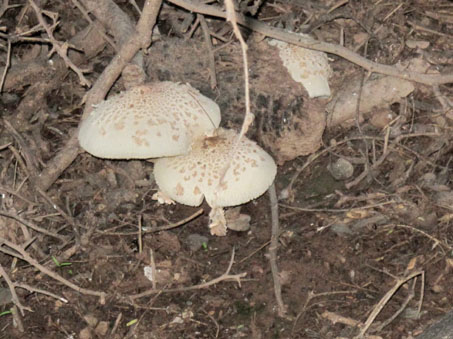
A group of particularly large mushrooms, about 6 cm in diameter growing in the soil. The dark patches are from the biological soil crust starting to dry up.
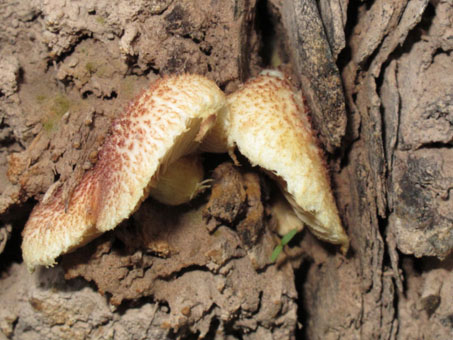
These two mushrooms were growing out from between what looked like scales in the trunk of a fallen palm tree. Each was about 3-4 cm in diameter.
While poking around in the dense vegetation, I came across Schaefferia cuneifolia, known locally as Sarampión (translation: measles), a woody shrub with very stiff branches and small leathery leaves. Ever since I first encountered this plant about 12 years ago, I’ve never seen the flowers, only the bright red fruit that give the plant its common name. So when I came across the plant and started looking for flowers as I usually do, I was taken aback by the fact that there were actually some present. I was extremely excited to be able to get photographs as well as voucher specimens with flowers. Jon was happy to take photos too, as he said he’d never seen the plant in bloom, except on herbarium sheets.
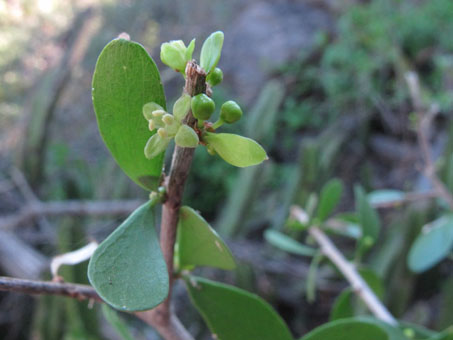
Sarampión (Schaefferia cuneifolia, Celastraceae). This is a common shrub in the desert scrub, well adapted with small, thick, leathery leaves, and thin, intricately arranged branches. The flowers are dioecious and have 4 green petals.
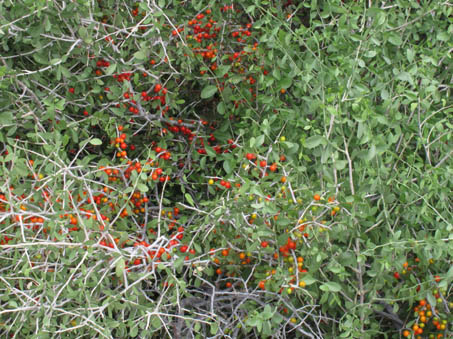
The common name is quite appropriate for this plant which looks like it´s broken out in measles. The fruit are fleshy drupes which are probably eaten mostly by birds. They have just a slight bitterness to them.
Jon is a walking encyclopedia on Baja California plants and also the only person that I have met who can walk through a field of knee-high Bermuda grass (Cynodon dactylon) and immediately pick out a few sprigs of a different grass species from the mass! Thanks to him, two more species were added that day to the inventory: Echinochloa colona (a non-native, annual grass) and the Baja California Green Violet, (Hybanthus fruticulosus, Violaceae) a native perennial herb more common at higher elevations, such as to the west of us in the Sierra de Guadalupe.
November 6-7, 2013
We decided to make an overnight botanizing trip to Loreto, 90 miles south of us. Part of the drive is along the western edge of Bahía Concepción and then after climbing a fairly low grade at about the halfway mark, the vegetation begins to change as the highway passes into the Sierra La Giganta phytogeographic region of the Sonoran Desert. It’s a little higher in elevation, the plant cover is subtly denser and there is a lot of underground water.
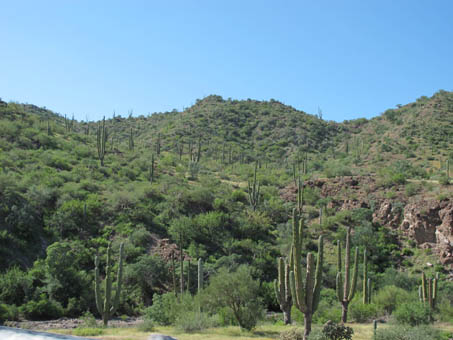
South of Bahia Concepcion and north of Loreto.
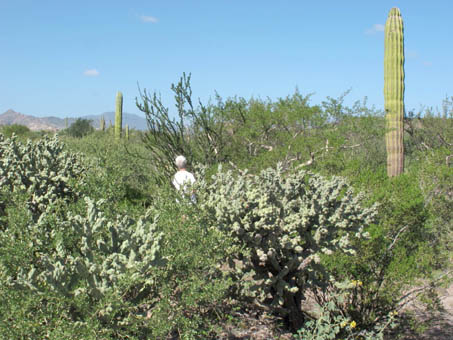
South of Bahia Concepcion and north of Loreto.
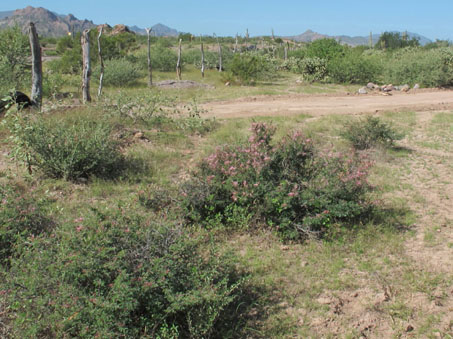
Tabardillo or Pink fairy duster (Calliandra eriophylla, Fabaceae).
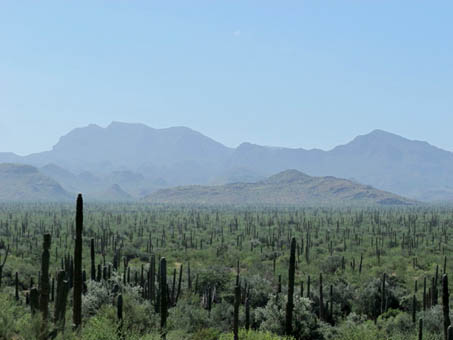
View of the Sierra La Giganta range north of Loreto.
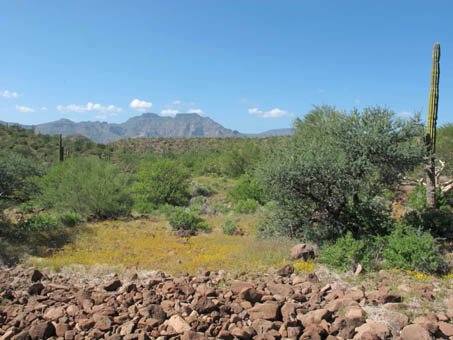
Wildflowers north of Loreto.
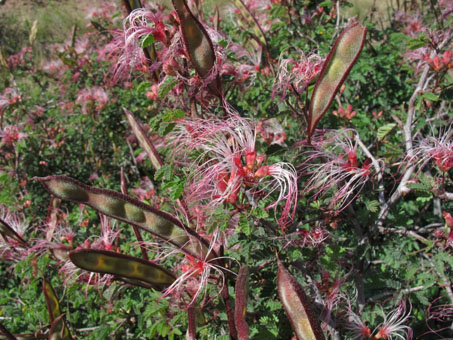
Tabardillo or Pink fairy duster (Calliandra eriophylla, Fabaceae)
In numerous arroyos, the endemic yellow morning glory (Merremia aurea), known locally as Yuca, draped the tops of trees 5-7 meters tall. For several kilometers, the roadside was blanketed in a native species of purple morning glories (Ipomoea ternifolia var. leptotoma), and golden yellow Chinchweeds (Pectis rusbyi and P. vollmeri).
There were a number of washouts, some of them major, along the highway, signs of a lot of water having flowed down into the lower lying Central Gulf Coast desert scrub. We soon found out that there had been so much water in Loreto after Octave that the aquifers were overflowing, and water was continuously bubbling up out of the ground in the downtown area (historically an oasis), closing a number of businesses.
Purple morning glories line the highway for kilometers, north of Loreto (Ipomoea ternifolia var. leptotoma, Convolvulaceae)
The morning glories were spectacular, especially highlighted by grasses and other wildflowers at the sides of the highway.
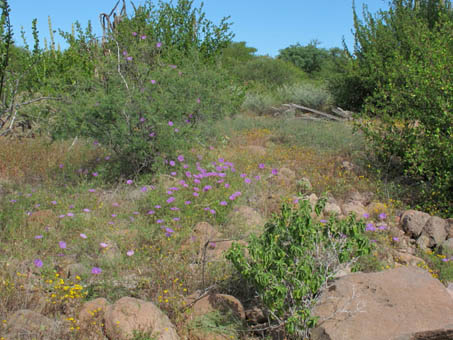
As I walked away from the highway into a densely vegetated wash, the morning glories were poking out of the grasses and draped on shrubs everywhere. The yellowish orange composite flowers are an endemic chinchweed (Pectis vollmeri, Asteraceae), which smells like lemon oil when crushed.
Before entering the town of Loreto in search of lodging and food, we continued right on by, heading south for about a half hour to an area where the escarpment of the Sierra La Giganta ends abruptly in high cliffs 0-2 km to the east of the highway. A friend who went south to La Paz in September said that the cliffs in this area had been sporting numerous waterfalls visible from the highway. Unfortunately by the time we visited, we didn’t see any waterfalls, but the mountains and bajadas (alluvial fans) were thick with vines, shrubs and annuals.
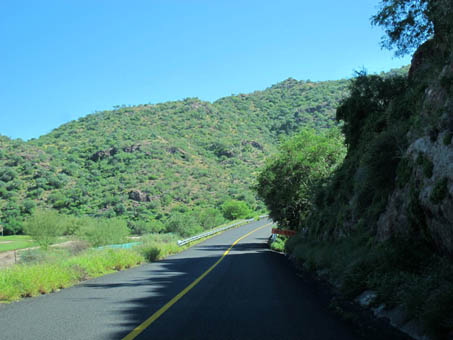
Highway heading south out of Loreto. Coralvine (Antigonon leptopus) and wild cucumber draped many plants.
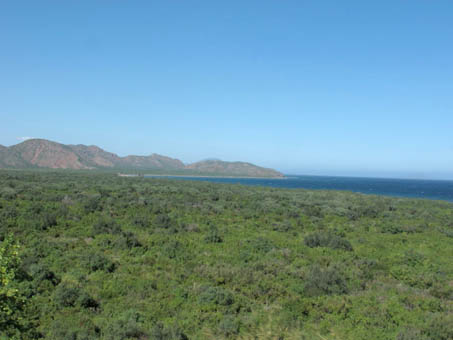
Densely vegetated alluvial fan from the Sierra la Giganta escarpment meets the Gulf not far south of Loreto.
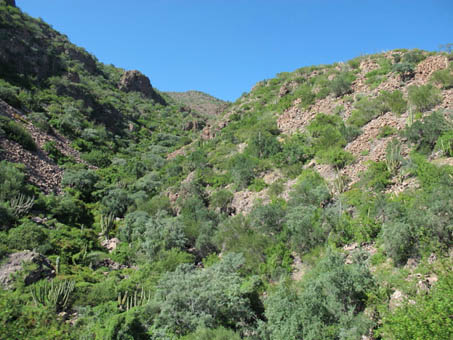
Densely vegetated hillsides of Sierra La Giganta, just south of Loreto near Juncalito.
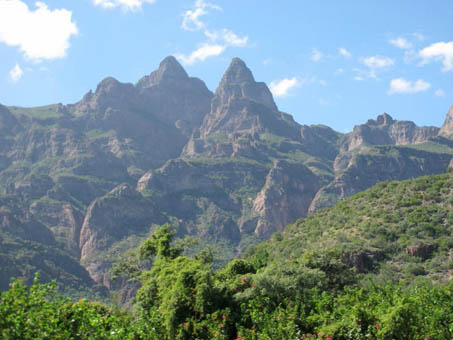
View of the Sierra La Giganta escarpment near the Gulf coast south of Loreto. Waterfalls could be seen here in September.
December 6, 2013
Mulegè is still incredibly green even now in December. The mountains around us are still quite lush and even though the groundcover is dying back, wildflowers abound and the shrubs and trees are still magnificent. We are off to Ensenada to attend the 11th Binational Botanical Symposium at UABC in Ensenada (Dec 12-13), where I will present on my Mulegé flora checklist and vegetation survey. As we headed north today, the abrupt change in the vegetation was evident within just 8-10 km north of town. It really hit me then that the town truly is an oasis and a unique place.
So, that’s it for this entry. I am going to try to add material this season on a more regular basis like a blog, in order to keep up with what’s happening currently. Feel free to check back between BEE issues because it’s been a really active couple of months and I’ve barely touched upon it here. Hasta pronto/See you soon!
— Debra Valov, curatorial volunteer






















